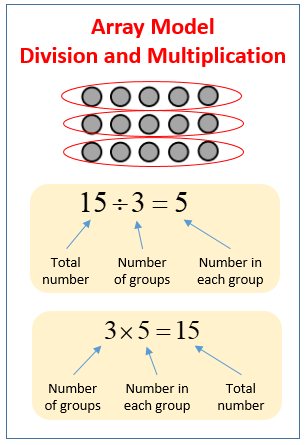Division using the Array Model
Related Topics:
Lesson Plans and Worksheets for Grade 3
Lesson Plans and Worksheets for all Grades
More Lessons for Grade 3
Common Core For Grade 3
Examples, solutions, and videos to help Grade 3 students learn how to interpret the unknown in division using the array model.
Common Core Standards:3.OA.1, 3.OA.3
New York State Common Core Math Grade 3, Module 1, Lesson 6
Worksheets for Grade 3
The following diagram shows how to use the array model for division and multiplication. Scroll down the page for more examples and solutions.

Printable Common Core Worksheets for Third Grade
Lesson 6 Concept Development
Word Problem: 20 children play a game. There are 5 children on each team. How many teams play the game? Write a division sentence to represent the problem.
Problem 1: Relate division to an array model.
Problem 2: Use an array to relate the unknown factor in multiplication to the quotient in division.
Problem 3: Relate multiplication and division.
Word Problem: I have 12 books. I put 4 books in each shelf. How many shelves will I need?
Lesson 6 Homework
- Mr. Hannigan puts 12 pencils into boxes. Each box holds 4 pencils. Circle groups of 4 to show the pencils in each box.
Mr. Hannigan needs _______ boxes.
______ × 4 = 12
12 ÷ 4 = ______ - Mr. Hannigan places 12 pencils into 3 equal groups. Draw to show how many pencils are in each group.
There are _______ pencils in each group.
3 × ______ = 12
12 ÷ 3 = ______ - Use an array to model Problem 1.
a) ______ × 4 = 12
12 ÷ 4 = ______
The number in the blanks represents:
b) 3 × ______ = 12
12 ÷ 3 = ______
The number in the blanks represents: - Judy washes 24 dishes. She then dries and stacks the dishes equally into 4 piles.
How many dishes are in each pile?
24 ÷ 4 = _______
4 × ________ = 24
What is the meaning of the unknown factor and quotient? - Nate solves the problem _____ × 5 = 15 by writing and solving 15 ÷ 5 = ____.
Explain why Nate’s method works. - The blanks in Problem 5 represent the number of groups. Draw an array to represent the number sentences.
Try out our new and fun Fraction Concoction Game.
Add and subtract fractions to make exciting fraction concoctions following a recipe. There are four levels of difficulty: Easy, medium, hard and insane. Practice the basics of fraction addition and subtraction or challenge yourself with the insane level.

We welcome your feedback, comments and questions about this site or page. Please submit your feedback or enquiries via our Feedback page.